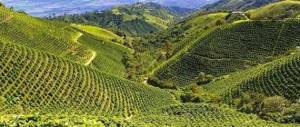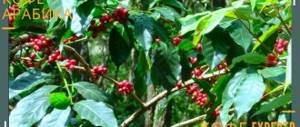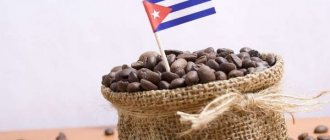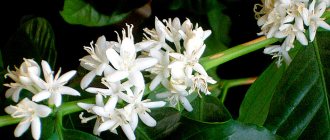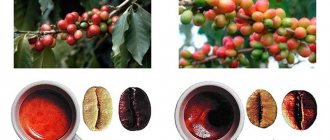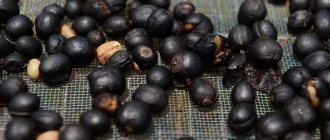Origin of Maragogype coffee
Harvesting coffee berries in Brazil
The origin of the variety is associated with the beginning of the emergence of coffee plantations in Brazil. In those days, coffee trees were planted randomly, without systematic distribution by variety. The goal was to identify varieties for which the Brazilian climate would be most favorable. The trees grew, and with the help of wind and insects, pollen was transferred from one tree to another - cross-pollination occurred. Thus, in 1876, a tree with large leaves and fruits was discovered, the size of which had not previously been found in any known variety of coffee. The resulting variety of Arabica was named Maragodjip - in honor of the city that was located next to the plantation.
The first plantations of the Maragodzhip variety were planted next to tobacco ones. This proximity significantly influenced the aroma of the beans - the taste of the finished drink gives off notes of tobacco.
History of the variety
In 1876, a tree with unusually large leaves and fruits was discovered on a Brazilian plantation. The plantation was located in the state of Bahia, in the vicinity of the city of Maragogip. Already in the 20th century, scientists found out that the gene responsible for the gigantic size of leaves and fruits is dominant, so the variety does not degenerate over time.
According to one version, Maragodzhip arose as a result of a spontaneous mutation of the Arabica variety Typica; according to another, cross-pollination of Arabica and Liberica occurred. Indirect confirmation of the second theory is the fact that Maragogipe beans have a very intense aroma, which is characteristic of Liberica, and a pleasant, unobtrusive sourness, characteristic of Arabica.

Features of the chemical composition, taste and aroma of grains
Maragogipe is a classic Arabica, but the size and structure of the beans have a decisive influence on the chemical composition, aroma and taste of coffee. The caffeine content in Maragogip beans is lower than that of other Arabica varieties, amounting to 0.5-0.8% of the composition. This results in a softer, more balanced taste.
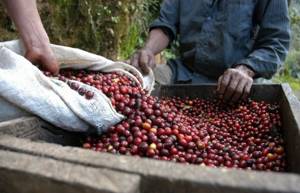
Coffee beans contain less caffeine than other Arabica beans, resulting in a milder taste.
Coffee beans contain about 18% essential oils. When frying, oils form an invisible film on the surface, which gives the taste and aroma characteristic of the variety. The place of growth has a direct influence on the aroma. Since the structure of Maragogype coffee beans is porous, they absorb odors with increased intensity. The finished drink takes on berry, fruit, chocolate, nut or tobacco shades.
The grains contain about 8% sugar. When roasted, the sugars give the fruit a deep, dark, uniform hue. In addition to the color, sugar softens the tart taste of coffee.
| Nutritional value of coffee (based on 10 grams of ground coffee per 100 ml of water) | |
| Squirrels, gr. | 0,2 |
| Fats, gr. | 0 |
| Carbohydrates, gr. | 0,3 |
| Potassium, gr. | 0,04 |
| Calories | 3 Kcal |
Coffee Maragogyp - its history
The birthplace of this interesting variety of Arabica is Brazil. It was there, in the city of Maragogip, that a coffee tree with unusual fruits first grew. This event happened a long time ago, at a time when coffee was not yet grown in Brazil. Hoping to grow coffee in their homeland, planters planted all known varieties and types of coffee trees in one place. As a result of this chaotic experiment, more than half of them died, and the rest were pollinated naturally, as a result of which such a hybrid was obtained.
This can be said by chance that the famous unique giant grains were obtained, which were 3-4 times larger than usual.
An interesting fact in its history is that the first coffee trees were planted in close proximity to tobacco plantations. This directly affected the taste and aroma of Maragogipe coffee beans.
Taste characteristics of this variety when grown on various plantations

Currently, Maragogipe coffee plantations practically do not exist in Brazil. This is due to the plant’s demands on external conditions (temperature, soil, humidity, lighting) and low yield. The annual yield per tree is almost 2.5 times lower than that of other Arabica varieties. Small plantations of Maragojipe can be found in Mexico, Guatemala, Colombia, Nicaragua and Hawaii.
Nicaragua
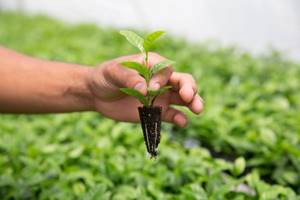
The largest Maragogipe grains are found in Nicaragua. They have a tart, thick, balanced taste with notes of wine. The sourness is less pronounced compared to the fruits of this variety grown on other plantations. The aroma of the finished drink is rich and noble. The taste of the drink is strong, thick, with floral or fruity undertones. The aftertaste is pronounced and gently reeks of chocolate. The higher above sea level the coffee plantations are, the lower the caffeine content. Maragojipe in Nicaragua grows at an altitude of 1400-1700 meters above sea level. Therefore, this drink does not cause heart palpitations. Ideal for a morning boost of energy.
Guatemala
Maragogipe, grown in Guatemala, is considered the best in Central America. This determines its origin - originally a Brazilian variety, and growing conditions close to ideal. There are three active volcanoes nearby, the ashes of which saturate the substrate for growing coffee with useful minerals. Guatemalan Maragogipe has a rich, bright taste with woody undertones. The sourness is pronounced. The aroma has a hint of smoke. The aftertaste is pleasant, with notes of black currant. The finished drink is tart, rich, and rich. With hints of fruit, flowers and smoke.
Mexico
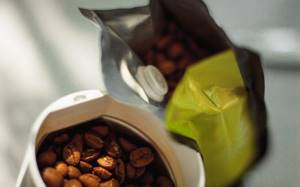
It is believed that the best variety, Maragogipe, grows in the south of Mexico. The taste of coffee from Mexico has the mildest, balanced taste. The sourness is weakly expressed. The aftertaste is soft, with hints of chocolate and nuts. The aroma is powerful, rich, bright. The caffeine content is naturally low. Therefore, Mexican Maragogip can be drunk in the evening.
Colombia

In Colombia, Maragogipe is the main variety to grow. Coffee has the most complete, rich taste. The taste is tart, slightly bitter, with fruity notes of apricot. The aroma is rich, pronounced, there are notes of baked milk. The aftertaste is soft, gives off cocoa. The drink is perfect for starting the day; it has pronounced invigorating properties. It should be cooked exclusively in a Turkish oven.
Hawaii

The rarest variety of the variety is the Hawaiian Maragodzhip. It is especially appreciated by coffee connoisseurs and lovers for its light honey-citrus flavor and chocolate aftertaste.
Maragogype coffee varieties
Each region has its own special flavors and aromas:
- Maragogipe coffee from Nicaragua is for those who prefer coffee with milk, but want to preserve the coffee notes in the drink. The variety has a light, attractive bitterness with notes of wine and tropical fruits. The drink turns out tart, thick, but at the same time with a reduced caffeine content.
- Maragogipe from Guatemala is the most elite, has a rich taste, complemented by hints of tobacco. This creates a strong drink with great flavor. By the way, this country is considered the leader in the production of this variety.
- Maragogipe from Mexico is light, has a chocolate, nutty and wine taste. The drink prepared from it has a slightly pungent taste, a sour tint and is of medium strength.
- Maragogipe from Colombia is easily identified by experts, as it is known for its hints of flowers, wine and nuts, and leaves a characteristic astringent aftertaste. Vanilla shades and the taste of baked milk are felt. It turns out to be very strong, so it is brewed in a Turk, and not in a coffee maker.
- Maragogipe from Brazil has high acidity and has light nutty and chocolate notes. The taste profile is light, many even find it too runny. Interestingly, although this country is the origin of the variety, it currently produces very little grain and its profile is poorer than in competing regions.
- Maragogip from Costa Rica is for lovers of a strong drink with pronounced shades of pear, prunes, and sun-warmed citruses.
- Maragogype from Cuba is thick and strong, has a slight bitterness and the classic aroma of sweet cocoa beans.
- Maragogyp from El Salvador is little-known but interesting, with a sweet chocolate taste and a bright cocoa aroma. The drink made from it is strong, dense, and perfectly invigorating.

The grain is always grown very high in the mountains, surrounded by tropical plantations, to protect the trees from the bright rays of the sun and retain the moisture they need.
Benefit

Coffee beans are high in nutrients. Regular consumption of this natural drink will protect you from the development of various diseases. For example, the likelihood of diabetes will decrease by 50% in men and by 30% in women if you drink 6 cups of coffee a day. Caffeine reduces the risk of developing Parkinson's disease. This is due to the fact that it inhibits signals in the nerve endings through which information is transmitted that triggers the disease.
The Maragogyp variety has a low caffeine content, for this reason it can be consumed by people prone to increased heart rate.
Grains grown on plantations located on volcanic rocks will fully replenish the body with minerals and vitamins.
Harm
Drinking coffee is associated with a high level of tonic properties. However, there is also a downside to positive influence. Yes, after using it you feel a significant surge of strength, however, after a few hours there is a decline. Coffee uses up the body's own reserves without bringing in energy from outside. Addictive. Under the influence of caffeine, the body's digestive system is in a state of stress and digestion is impaired.

The consumption rate for pregnant women should be reduced as much as possible.
The daily intake of coffee is 2 cups of 200 ml, for pregnant women it should be halved.
Drinking is contraindicated:
- with high blood pressure;
- for glaucoma;
- with renal failure;
- for coronary heart disease and atherosclerosis;
- children;
- in old age.

As mentioned above, the structure of the grains of the Maragodzhip variety is loose and absorbs substances contained in the environment. Therefore, you should be careful when choosing grains to avoid purchasing a product grown in unfavorable conditions.
Average cost and best brands
It is possible to feel and enjoy the real taste of Maragogip coffee only when purchasing a quality product from a responsible manufacturer. The average cost of 250 grams of coffee beans is quite high, starting from 600 rubles. This is due to the fact that the capricious variety requires increased growing conditions, while its productivity is low compared to others. Producers are abandoning it in favor of other Arabica varieties. Against this background, Maragodzhip becomes rare, and its price rises.

Due to difficulties with cultivation, prices for Maragogype are quite high
The most convenient ways to purchase your favorite drink are online stores and specialized coffee shops. When choosing coffee, give preference to the following brands:
- Malongo;
- Blues;
- The royal courtyard.
Maragogyp coffee: what is it?
Maragodzhip (the emphasis in the word is on the last syllable) is a type of Arabica, only with very large grains.
An interesting feature is the structure of the beans, which is very loose and porous, which allows you to grow coffee enriched with a large amount of oxygen and nutrients.
In addition, maragogype contains a small amount of caffeine, but has a bright and strong aroma.
In its pure form, this coffee has a very specific taste, so it is often used in various coffee blends and mixes.
The taste of coffee varies depending on where it is grown, the weather and the time of harvest.
True lovers of the Maragogyp variety claim that each batch of beans is not the same in taste.
But one thing remains unchanged - an incredible chocolate taste, with a characteristic coffee sourness , and a delicate, unobtrusive tobacco smell of the finished drink.
Trees of the Maragojipe variety are not very productive, so you won’t be able to buy this kind of coffee in a regular store, and not everyone can afford its price.
A list of all types of coffee with names can be found in our article at this link.
Bean storage options

The processing of the grains has a direct impact on the shelf life. Fresh green grains can be stored for a year - they will not change their properties. Roasted grains are less stable, they are able to absorb foreign odors and moisture from the air, so their shelf life in a paper bag is no more than two weeks. Foil packaging will preserve coffee for three months, and in a tightly closed glass or ceramic container the beans can be stored for six months.
